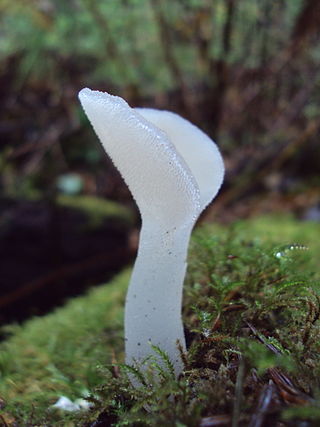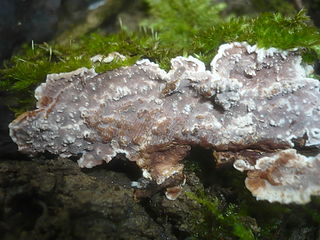
Pseudohydnum gelatinosum, commonly known as the toothed jelly fungus, cat's tongue, or jelly tooth, is an Eurasian species of fungus in the order Auriculariales. Its common names refer to its gelatinous consistency and hydnoid (toothed) undersurface.

The Auriculariales are an order of fungi in the class Agaricomycetes. Species within the order were formerly referred to the "heterobasidiomycetes" or "jelly fungi", since many have gelatinous basidiocarps that produce spores on septate basidia. Around 200 species are known worldwide, placed in six or more families, though the status of these families is currently uncertain. All species in the Auriculariales are believed to be saprotrophic, most growing on dead wood. Fruit bodies of several Auricularia species are cultivated for food on a commercial scale, especially in China.

The Auriculariaceae are a family of fungi in the order Auriculariales. Species within the family were formerly referred to the "heterobasidiomycetes" or "jelly fungi", since many have gelatinous basidiocarps that produce spores on septate basidia. Around 100 species are known worldwide. All are believed to be saprotrophic, most growing on dead wood. Fruit bodies of several Auricularia species are cultivated for food on a commercial scale, especially in China.

The hydnoid fungi are a group of fungi in the Basidiomycota with basidiocarps producing spores on pendant, tooth-like or spine-like projections. They are colloquially called tooth fungi. Originally such fungi were referred to the genus Hydnum, but it is now known that not all hydnoid species are closely related.

Pseudohydnum is a genus of fungi in the order Auriculariales. Basidiocarps are typically bracket-like and gelatinous, with or without a stipe, with a hydnoid (toothed) undersurface. The genus is widely distributed in both the northern and southern hemisphere, with thirteen species currently described and others awaiting description.
Eichleriella is a genus of fungi in the order Auriculariales. Species produce effused or cupulate, waxy to leathery basidiocarps on wood, with a smooth to spiny surface. The genus currently contains more than 15 species.
Heterochaete is a genus of fungi in the order Auriculariales. Species produce effused, gelatinous, waxy, or leathery basidiocarps on wood, partly or wholly covered in small sterile spines or pegs. The presence of these sterile spines distinguishes the genus from Exidiopsis, species of which are microscopically similar but have smooth basidiocarps.

Ceratobasidium is a genus of fungi in the order Cantharellales. Basidiocarps are effused and the genus is sometimes grouped among the corticioid fungi, though species also retain features of the heterobasidiomycetes. Anamorphic forms were formerly referred to the genus Ceratorhiza, but this is now considered a synonym of Rhizoctonia. Ceratobasidium species, excluding the type, are also now considered synonymous with Rhizoctonia and some species have been transferred to the latter genus. Species are saprotrophic, but several are also facultative plant pathogens, causing a number of commercially important crop diseases. Some are also endomycorrhizal associates of orchids.

The Ceratobasidiaceae are a family of fungi in the order Cantharellales. All species within the family have basidiocarps that are thin and effused. They have sometimes been included within the corticioid fungi or alternatively within the "heterobasidiomycetes". Species are saprotrophic, but some are also facultative plant pathogens or are associated with orchid mycorrhiza. Genera of economic importance include Ceratobasidium and Rhizoctonia, both of which contain plant pathogenic species causing diseases of commercial crops and turf grass.

Heteroradulum is a genus of fungi in the order Auriculariales. Species produce effused, leathery basidiocarps on wood, often pinkish red and partly or wholly covered in small sterile spines. The genus was originally published in 1917 by American mycologist Curtis Gates Lloyd under the facetious pseudonym "McGinty", rendering the name invalid. It was validated a century later to accommodate a group of species formerly placed in the genera Eichleriella or Heterochaete, but not closely related to either.
Protomerulius is a genus of fungi in the order Auriculariales. Basidiocarps are formed on dead wood and have an effused, smooth, spiny, or poroid hymenium. The genus is cosmopolitan.
Aporpium is a genus of fungi in the order Auriculariales. Basidiocarps are formed on dead wood and have a poroid hymenium. Species were often formerly referred to the genera Elmerina or Protomerulius, but molecular research, based on cladistic analysis of DNA sequences, has shown that Aporpium is a distinct, mainly north temperate genus.
Elmerina is a genus of fungi in the order Auriculariales. Basidiocarps are formed on dead wood and are either bracket-like with a poroid hymenium or densely clavarioid. Species are known from East Asia and Australia.

Tremellochaete is a genus of fungi in the family Auriculariaceae. Species produce pustular or lobed, effused, gelatinous basidiocarps on wood, typically covered in small sterile spines or pegs.
Amphistereum is a genus of fungi in the family Auriculariaceae. Species produce cupulate to effused, leathery basidiocarps on wood. Microscopically, fruit bodies have a dimitic hyphal system. The genus is currently only known from North and South America.
Proterochaete is a genus of fungi in the family Auriculariaceae. The type and only species, Proterochaete adusta, produces thin, effused, corticioid basidiocarps with a smooth or spiny surface on wood. The species was originally described from North America and is also known from northern Europe and Asia.
Sclerotrema is a genus of fungi in the family Auriculariaceae. The type and only species, Sclerotrema griseobrunnea, produces effused, corticioid basidiocarps on wood with a smooth surface. The species was originally described from Russia and is also known from Canada.

Protodaedalea is a genus of fungi in the family Auriculariaceae. Species produce bracket-like basidiocarps on wood with a lamellate (gilled) undersurface. The genus currently comprises two species, both known from Asia.
Crystallodon is a genus of fungi in the order Auriculariales. The type and only species, Crystallodon subgelatinosum, forms effused, gelatinous, basidiocarps covered with small, sterile spines on fallen wood. The species was formerly placed in Heterochaete, but molecular research, based on cladistic analysis of DNA sequences, indicates that Crystallodon is distinct. The species was originally described from Panama and has also been recorded from Brazil.
Hirneolina is a genus of fungi in the order Auriculariales. Basidiocarps are effused, waxy, and occur on dead wood. Only the type species, described from Ecuador and reported from Brazil, is currently confirmed as belonging to the genus.









